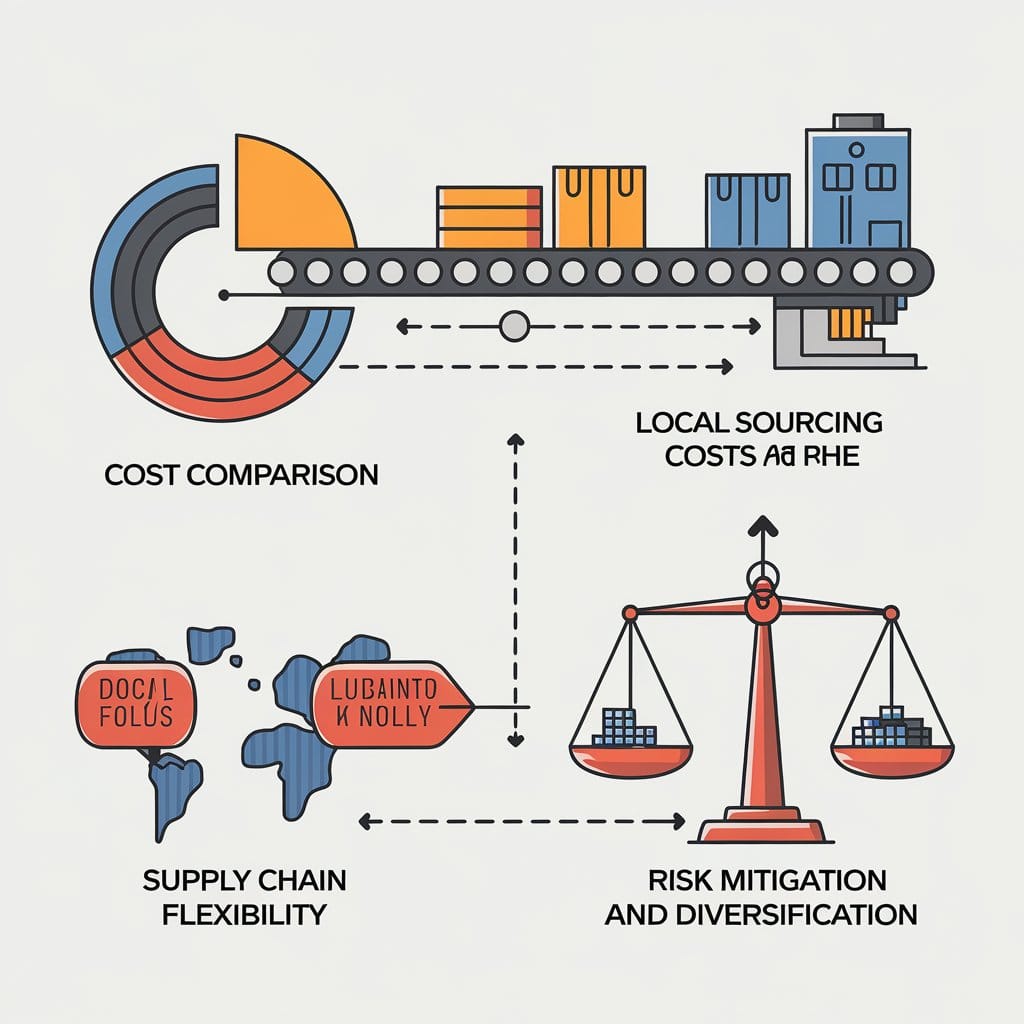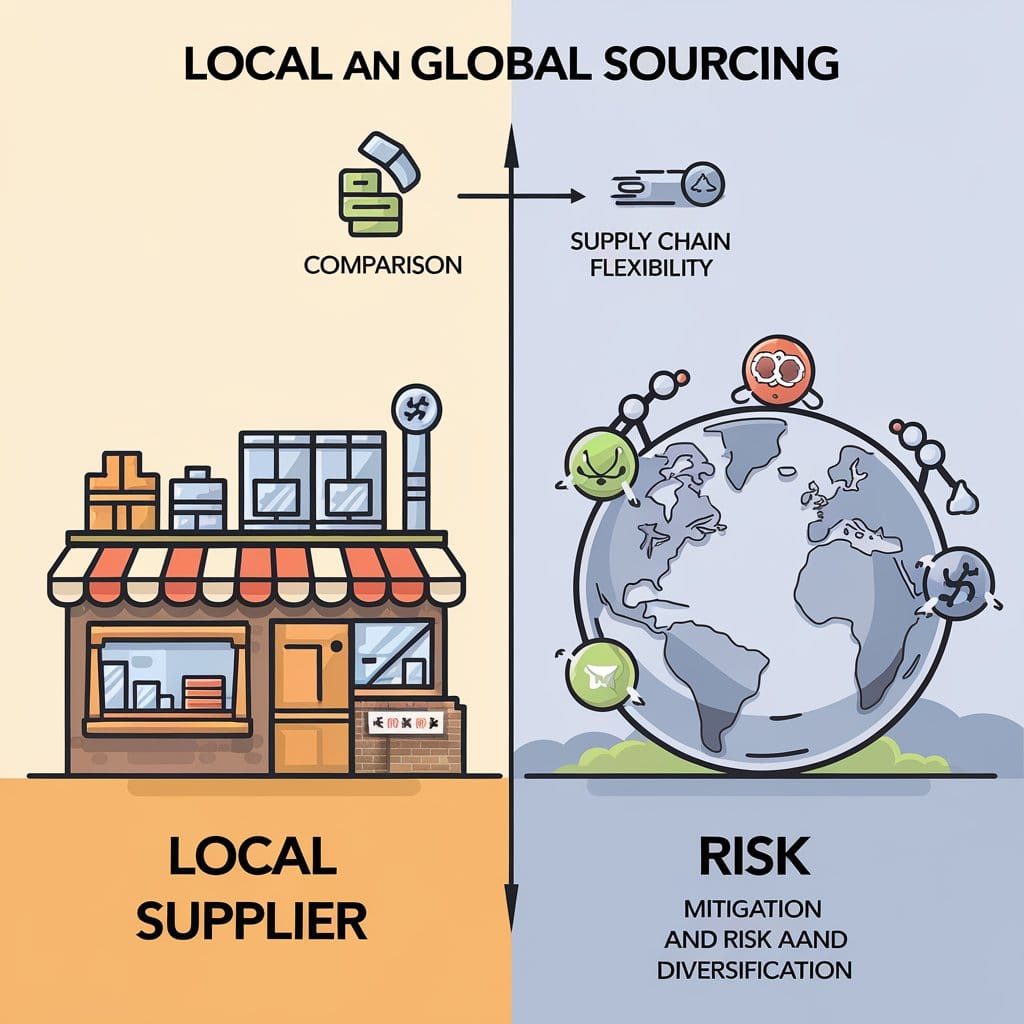When running a business, one of the most crucial decisions you’ll face is where to source your materials or finished products. Two major strategies are local sourcing and global sourcing, each offering unique benefits and challenges. Whether you’re a contractor, brand owner, or any other type of business leader, understanding these sourcing options is vital to making the right decisions for your company.
In this article, we’ll compare local sourcing with global sourcing, focusing on the advantages and challenges of each approach. We’ll also take a deeper look into global sourcing from China, a popular destination for businesses worldwide.
Understand Local Sourcing

What is Local Sourcing?
Local sourcing refers to the practice of purchasing materials or products from suppliers that are based in the same country or region as your business. For many businesses, this approach is appealing because it allows them to support local economies, reduce transportation costs, and streamline communication with suppliers. Local sourcing typically leads to shorter lead times and easier control over quality, especially when working within the same time zone and legal system.
Advantages of Local Sourcing
Lower Shipping Costs
Local sourcing eliminates long-distance transportation expenses, which can be a significant factor in your overall costs. When suppliers are nearby, you’re likely to save money on shipping and reduce the carbon footprint associated with transporting goods over long distances.
Faster Turnaround Times
Working with suppliers close by often means shorter delivery times. This can be particularly useful in industries where speed to market is critical. If you need to respond quickly to market demands or fulfill customer orders fast, local sourcing offers a clear advantage.
Quality Control and Communication
With suppliers located nearby, it becomes much easier to perform inspections, oversee manufacturing processes, and resolve issues quickly. Face-to-face communication is more frequent, helping avoid misunderstandings and errors.
Supporting Local Economy
Local sourcing often allows companies to contribute to their community and support local jobs, which can be an important part of a business’s social responsibility strategy.
Challenges of Local Sourcing
Higher Production Costs
While you save on shipping, labor costs and other expenses may be higher locally. In countries with high labor standards, businesses may find that the price of materials or production is significantly more expensive compared to countries with lower labor costs, such as China or Vietnam.
Limited Product Availability
Sourcing locally may limit your access to certain materials or specialized products that aren’t readily available in your region. This can restrict your options if you’re trying to create innovative products that require advanced technologies or rare materials.
Less Flexibility
Sometimes, local suppliers may have less ability to scale production quickly, especially if you’re in an industry with fluctuating demand. Sourcing locally can mean fewer options for rapid expansion or sourcing from multiple locations.
The Case for Global Sourcing

What is Global Sourcing?
Global sourcing is the practice of sourcing goods or materials from suppliers located in other countries, often in places where labor costs are lower or specific raw materials are more abundant. Companies engage in global sourcing to take advantage of lower prices, specialized products, or manufacturing techniques that aren’t available locally.
Benefits of Global Sourcing
Cost Efficiency
The most obvious benefit of global sourcing is cost savings. Countries like China, India, and Vietnam have much lower labor costs compared to developed countries. By sourcing from these regions, businesses can reduce their production costs, which can significantly improve profit margins, especially for high-volume products.
Access to Specialized Products
Global suppliers may offer products or materials that aren’t available locally. Whether it’s cutting-edge electronics, specific textiles, or high-precision machinery, sourcing globally enables you to access a broader array of goods. This is particularly beneficial for industries that rely on specialized manufacturing or unique materials.
Scalability
Global suppliers often have larger production capabilities and are better equipped to handle fluctuations in demand. If your business needs to quickly scale up or down, global sourcing offers the flexibility to meet those demands with ease.
Wider Supplier Network
By tapping into global suppliers, you can diversify your supplier base. This means having more options for negotiation and avoiding over-reliance on a single source, which can reduce potential risks in your supply chain.
Drawbacks of Global Sourcing
Higher Shipping and Import Costs
One of the main disadvantages of global sourcing is the added cost of international shipping. Shipping from overseas is often more expensive and takes longer, which can lead to delays and increased costs, especially if tariffs and import taxes are involved.
Quality Control
Maintaining consistent product quality is harder when working with suppliers in different countries. Different countries have varying standards for manufacturing, which can lead to issues with product defects, poor craftsmanship, or inconsistency in delivery timelines. This can result in a need for more intensive oversight, such as third-party inspections.
Communication Challenges
Working with global suppliers often comes with language barriers and differences in time zones. These challenges can make communication more difficult, leading to potential misunderstandings or delays in decision-making.
Geopolitical Risks
Political instability, trade wars, or changes in government policies can affect your global supply chain. For instance, tariffs or sudden restrictions on certain products can result in unexpected costs or delays, adding uncertainty to your business operations.
Key Advantage of Global Sourcing from China

Why Choose China for Global Sourcing?
China has long been one of the world’s leading global sourcing destinations, largely due to its cost-effective labor force, highly efficient manufacturing infrastructure, and ability to produce a wide variety of goods. Whether you’re sourcing electronics, textiles, toys, or consumer goods, China is capable of providing high-quality products at competitive prices.
Cost-Effective Manufacturing
China’s vast manufacturing network and lower labor costs make it an attractive option for businesses looking to reduce production costs. The country has made significant investments in technology and infrastructure, ensuring that production remains efficient while keeping costs low.
Wide Product Range
From simple components to complex electronic devices, Chinese manufacturers can produce nearly any product. Their ability to scale production means that businesses can easily source a broad variety of goods from a single country.
Sophisticated Supply Chain
China’s advanced logistics systems ensure that goods can be delivered efficiently around the world. The country has a highly developed infrastructure, from ports and airports to transportation networks, ensuring that shipments move quickly and reliably.
Overcoming Challenges of Sourcing from China
Quality Control
Despite the many advantages, ensuring high product quality from China can be a challenge. Working with a reliable third-party inspection service or a local sourcing agent can help mitigate risks associated with substandard products.
Logistics and Shipping Costs
Even though China offers lower production costs, shipping internationally can be expensive. It’s essential to account for shipping time, tariffs, and import duties in your overall cost analysis.
Cultural and Communication Barriers
Language barriers and cultural differences can complicate business relationships with Chinese suppliers. Clear, detailed contracts and regular communication are crucial to maintaining smooth operations.
Key Considerations between Local Sourcing and Global Sourcing

Cost Comparison: Local vs Global
When it comes to cost, global sourcing often has the edge due to lower labor costs in countries like China and India. However, this is offset by higher shipping, tariffs, and customs duties. Local sourcing, on the other hand, tends to have lower upfront shipping costs but may be hindered by higher production costs and less variety in available products.
Supply Chain Flexibility
Global sourcing offers greater flexibility, especially when sourcing from a wide network of suppliers. You can scale production to meet changing demand more easily. On the other hand, local sourcing provides more control over logistics and quicker turnaround times, which can be beneficial if you need faster adjustments.
Risk Mitigation and Diversification
Global sourcing offers risk mitigation through diversification. By sourcing from multiple countries, businesses reduce their exposure to regional risks like natural disasters or political instability. Local sourcing, however, is more vulnerable to disruptions in a single region but can be more predictable in stable markets.
Which Sourcing Strategy is Right for Your Business?

Great! Since the table will be part of a section titled “Which Sourcing Strategy Is Right for Your Business?”, here’s a revised version with a decision-friendly tone, focused on helping business owners weigh their options. I’ve made it more conversational and aligned it with that purpose:
Global Sourcing vs. Local Sourcing: Which One Suits Your Business?
| Factor | Global Sourcing | Local Sourcing |
|---|---|---|
| Cost Advantage | Often lower unit costs thanks to cheaper labor and materials abroad | Typically higher costs, but fewer hidden fees and more predictable pricing |
| Delivery Speed | Longer lead times due to shipping, customs, and distance | Faster turnaround times and easier logistics |
| Product Availability | Wider variety and access to specialized products or tech | May be limited to what’s available locally or regionally |
| Quality Oversight | Harder to monitor quality regularly; may need third-party audits | Easier to visit suppliers and maintain consistent standards |
| Communication | Potential time zone, cultural, or language barriers | Smoother communication and shared business culture |
| Scalability | Easier to ramp up production through larger supplier networks | May face limitations in production capacity |
| Supply Chain Risks | Prone to global disruptions (e.g., port delays, political instability, pandemics) | Less exposed to global risks but still vulnerable to regional disruptions |
| Sustainability Goals | Higher environmental impact due to long-distance transport | Supports greener practices with reduced emissions and local engagement |
| Legal & Compliance | Must navigate foreign trade laws, taxes, and customs | Easier to manage local regulations and compliance standards |
| Brand Story & Community Impact | May not align with “buy local” values customers care about | Enhances local economy and may appeal to socially conscious consumers |
| Best Fit For | Businesses prioritizing cost savings, high-volume needs, or unique materials | Businesses focused on speed, quality control, local loyalty, or sustainability |
Factors to Consider When Choosing a Sourcing Strategy
When deciding between local and global sourcing, consider factors like:
- Product Type: If you require specialized products, global sourcing may be necessary.
- Cost Control: For businesses looking to cut costs, low cost country sourcing like global sourcing may be the best choice, especially when considering labor costs.
- Lead Time: If your business requires quick production and delivery, local sourcing could be a better option.
Combining Global and Local Sourcing
Many businesses find success with a hybrid sourcing strategy, using both local and global suppliers. For example, you can source common, low-cost products locally while relying on global suppliers for specialized materials or components. This approach allows businesses to balance cost efficiency with flexibility and quality control.
Make the Right Sourcing Choice for Your Business
The choice between local sourcing and global sourcing depends on several key factors, including cost, quality, supply chain flexibility, and risk management. If your business is seeking the lowest costs and specialized products, global sourcing—particularly from low cost countries like China—can offer significant advantages. However, local sourcing may be the best choice if speed, communication, and quality control are top priorities.
Ultimately, finding the right balance between these two approaches is crucial to your business’s long-term success. Consider your specific needs, objectives, and the type of products or services you offer when making your decision. In some cases, combining both strategies—local sourcing for rapid turnaround and global sourcing for cost-efficiency—could be the most effective approach.
By carefully considering the pros and cons of local vs. global sourcing, and leveraging the best of both worlds, you can build a resilient, efficient supply chain that meets your business’s needs now and in the future.
Go Global with Alibaba.com: Source and Sell Worldwide
Alibaba.com is a leading global online marketplace that connects businesses with suppliers and manufacturers across the world. What began in China in 1999 has grown into a trusted platform for both sourcing and selling on a global scale.
For B2B Buyers: Simplify Your Sourcing with Alibaba.com
Whether you’re looking for local suppliers or international manufacturers, Alibaba.com makes it easy to find reliable partners in just minutes. With thousands of verified suppliers across virtually every industry, it’s your one-stop platform for discovering, evaluating, and ordering products.
From product discovery and quality checks to shipping and secure payment, every step of the sourcing process is streamlined on Alibaba.com. Competitive pricing helps increase your margins, while the platform’s built-in safeguards ensure peace of mind—regardless of the size of your business.
Instead of juggling emails and time zone differences trying to reach suppliers, head to Alibaba.com and connect with high-quality manufacturers offering affordable bulk solutions—all in one place.
For B2B Sellers: Connect with Global Buyers and Grow Your Business
With millions of active buyers from over 190 countries and regions browsing 40+ product categories, Alibaba.com gives sellers unmatched access to global demand. Thousands of inquiries are made daily, offering sellers direct exposure without the need to attend trade shows or spend on travel.
Your digital storefront is open 24/7, helping you attract new customers, generate leads, and close sales—all without paying commission in most countries.
Even if you’re new to global trade or eCommerce, Alibaba.com provides tools and tailored service to help you succeed from day one. The platform is designed to support your growth at every stage of your selling journey.







-300x198.png)